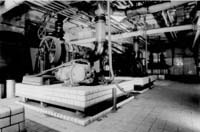Warning: The text reproduced here is a copy of information published elsewhere. This information has either:
- been published freely on the internet and has been cached here as a precaution against future loss of servers and links, or
- been published historically and very few copies of the original text are still available for research purposes.
It is recommended that you look at the original source given below first, and use this text only if that source is not available to you. It is not intended that any text cached here infringe the copyright of the original author. If any copyright owner wishes their text removed from this site, this can be done by contacting the author.
Document summary:
- Title: Berliner Unterwelten - Pneumatic Dispatch System
- Author:
AUTHOR: Ingmar Arnold - Source: http://www.berliner-unterwelten.de/en/002/c/dat_rohrpost/content.htm
- Copyright: 2001 Berliner Unterwelten e.V.
- Date: 14 April 2001
Pneumatic Dispatch System
- In Operation: 1865-1976
- Size: 400 kilometres
- Function: Pneumatic dispatch system
- Condition: Dismantled, a few stations still exist
- Accessibility: No access possible
Description
Berlin once had a very special sight: The pneumatic dispatch system (1865-1976), with its 90 stations and 400 kilometres of tubes, was the second largest of its kind after Paris and its technology was exported on a large scale. The heart of Germany's pneumatic dispatch industry was located at the river Spree and exported its products to most European countries and across the oceans, especially to South America. This fascinating chapter of travel and communications history has nowadays almost been forgotten about, with most of the tubes having been dug up. The few remaining stations are acutely threatened by the immense building and investment activities currently taking place in Berlin - blurring the memory of a system which played an important part in Berlin's development into Germany's leading metropolis with international status.
Almost forty years ahead of its big sister, Berlin's "little metro" already buzzed through the underground, delivering up to eight million dispatches annually, at times operating around the clock. The mail delivered by pneumatic dispatch took only about an hour to reach the addressee - even modern bike couriers cannot match that performance! This most innovative technology has, unjustifiably, nowadays largely been forgotten.

Berlin's pneumatic dispatch system (1865-1976) was one of the most unconventional and fascinating networks of Berlin's underground. In the 111 years of ist existance, the "little metro" may not have transported any living passengers, but it was 40 years ahead of its big sister, Berlin's underground railway system.
Pneumatic dispatch is a special method of transporting letters, postcards, telegrams, small parcels and goods through tubes from one station to another, using pressurised air to do so. There are different types of pneumatic dispatch systems. Internal networks are used within pharmacies, banks, factories, hospitals, post offices, mail order offices, insurance companies, warehouses and newspaper offices. Long-distance networks connect buildings which are some distance apart from one another.
The pneumatic dispatch system was a product of the industrial revolution, a key technology of its time and an all-European and transatlantic phenomena. The most important urban centres in Europe and overseas were connected to one another and exchanged their experiences with the system. So, for example, Berlin's system was built by engineers from Vienna and Paris while the German Siemens company went to London to demonstrate its own system there - not without success.
American postal officials regularly went to Europe in order to study the pneumatic dispatch networks there and apply the experiences to their own country. The pneumatic dispatch system had its heydays between 1860 and 1945. In those years, it recorded the highest number of dispatches. Thereafter, it went into decline because of new technologies which replaced it and was subsequently forgotten about.

The English and French terms "pneumatic tube" and "la tube pneumatique" literally spell out what the "Rohrpost", as the system is called in German, actually is: "Pneumatic tubes are used to transport letters, small parcels, telegrams and so on across a certain distance by means of pressurized air." Berlin's system was initially called "pneumatische Depeschenbeförderung". The Royal Prussian Telegraphs Direction watched the introduction of London's first pneumatic dispatch system in 1861 with great interest and commissioned the Siemens & Halske company to build such a network for Berlin. The first line between the main telegraphs office and the stock exchange entered service in 1865, a second one following in 1868. This original system still suffered from teething troubles, such as the problems occuring during extreme changes ofclimate. The system was consequently reorganised after 1870 and made available to the public in 1876. At this point, it also got its name "Rohrpost" which was coined by the General Post Director Heinrich von Stephan and quickly spread in all German-speaking countries.
The rise of Berlin's pneumatic dispatch system was unstoppable. Starting with 15 offices and 4 machine houses, it had extended to 90 offices, 400 kilometres of tubes and 12 high speed lines by 1939, delivering some 8 million dispatches per year. It was thus the biggest system of its kind in Germany and the world's second largest after Paris. But the Second World War and the cold war had a devastating impact on it. By 1945, a large proportion of the tubes, located directly under the pavement, had been destroyed by bombing. And just when the most basic repairs had been carried out, the city's division began, also affecting the underground networks in its wake. In 1949, the Russian sector cut its pneumatic dispatch connections to the western sector. The two parts were never to be linked again. While East Berlin's system shrank to some 65 kilometres, new stretches were actually built in West Berlin, where the system had 167 kilometres of tubes. New communication techniques such as telefax, however, clearly indicated that that the demise of the system was only a question of time. West Berlin's public system terminated its operations in 1963. Some deliveries were still carried out in the following years but in early 1972 the whole network was shut down. East Berlin continued its regular pneumatic dispatch until about 1976, with some internal administrative deliveries continuing into the 1980s.
Nowadays, Berlin's pneumatic dispatch system is history. But the technology as such is still in operation. Several countries in Germany and other countries continue to install such systems. Pneumatic dispatch will continue to play a role, even if just for internal deliveries. In the age of e-mail and faxes it is still necessary, after all, to transport original documents quickly from one location to another. The history of this fascinating means of transport teaches us that human inventiveness and phantasy transcend the boundaries of time. The fathers of the pneumatic dispatch system have played their part in making this world what it is today.
Please take a look at the book "Luft-Züge - Die Geschichte der Rohrpost in Berlin und anderswo" (Air Trains - The history of pneumatic dispatch systems in Berlin and elsewhere) by Ingmar Arnold in our book suggestion section:
Air Trains
Have you ever heard about Berlin's "little metro", buzzing away just one metre under the pavement? Come and join us on an interesting trip into the history of Berlin's pneumatic dispatch system. With a speed of up to 16 metres per second, the system's cartridges whizzed around literally under the Berliners' feet. For some 100 years, the pneumatic dispatch system was one of the city's most important means of communication and underlined Berlin's importance as a modern metropolis.
This book deals with the (worldwide) development, the eventful history and the decline (for the time being) of a little technological marvel.
Luft-Züge
Die Geschichte der Rohrpost in Berlin und anderswo
Ingmar Arnold
Verlag GVE 2000
ISBN 3-930863-33-2
DM 29,80 (Euro 15,24)